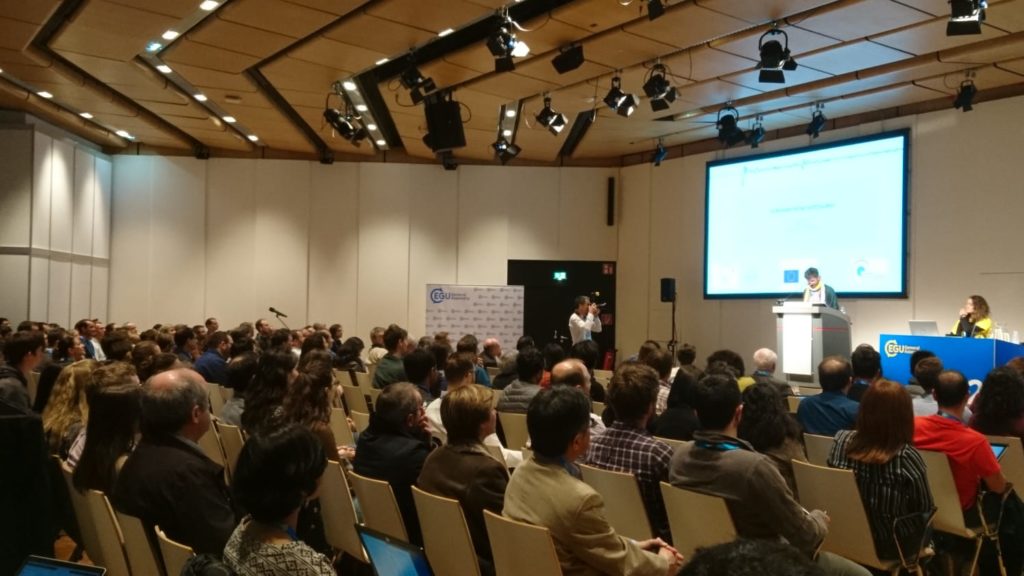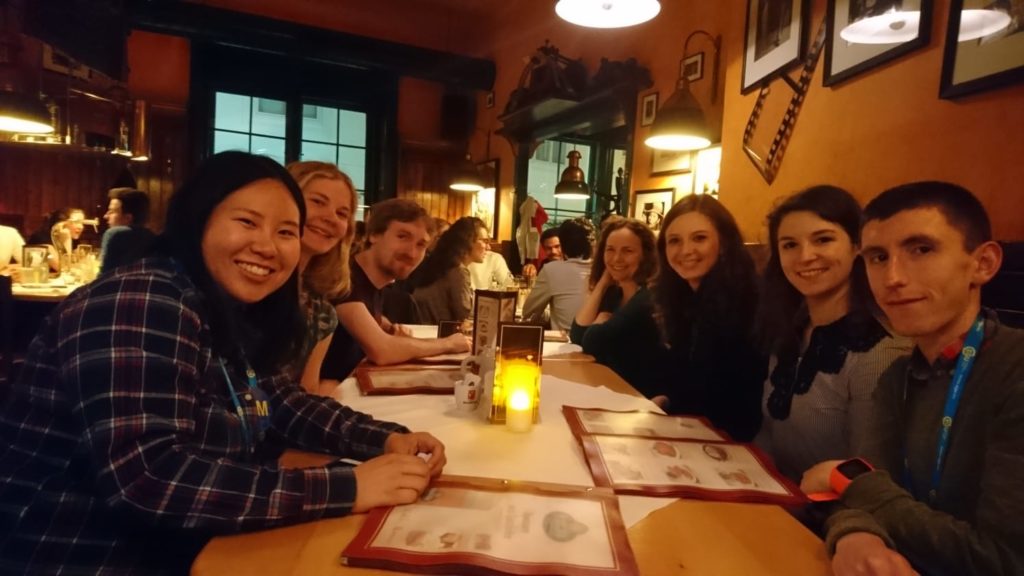A brief review, highlighting the short course series Solid Earth 101, the Early Career Scientist strategy, and the impressions on the EGU General Assembly from your editorial staff.
Over 16 000 scientists from 113 countries, more than 1000 different conference related events and a schedule overflowing with science, awards ceremonies, short courses, policy making, and – if you know where to look – free lunches. The EGU General Assembly was a highlight in the year for many, and a way to catch up with colleagues and friends one only meets once or twice a year.
This year for the first time, Seismology teamed up with Geodynamics and Tectonics to provide an integrated series of Short Courses, Solid Earth 101. This collaboration built on our years of experience presenting Seismology for non-seismologists and the Geodynamics 101 courses. More on these courses in a separate post!
Another old favourite was the well attended Wednesday evening get-together in Bermuda Bräu.
This year, the Seismology division awards went to Annie Souriau and Piero Poli. Annie Souriau was awarded the Beno Gutenberg medal for her life-long contributions to knowledge ranging all of the Earth’s interior, but especially the core. Piero Poli received the Early Career Scientist award for his varied work ranging from ambient noise interferometry to earthquake physics and machine learning.

The 2019 Division Outstanding Early Career Scientists Award is awarded to Piero Poli for innovative research in seismic interferometry and earthquake seismology.
Even before the GA started, the Early Career Scientist representatives got together on Saturday for the ECS planner workshop. Given that about half of the EGU membership are ECS, it is about time we make sure that our concerns are incorporated into the EGU strategy. This was exactly the purpose of this workshop, and the day was spent defining themes that are specifically important for ECS and developing thoughts about strategy on them. In this context, we focused our thoughts on work/life balance – (non-)academic careers – ECS role in EGU and in the scientific programme of the GA – connectivity. Our next objective is the development of a strategy for these themes, so stay tuned, and send us your thoughts on what EGU can do to make things easier / better for ECS – or scientists in general.
so stay tuned, and send us your thoughts on what EGU can do to make things easier / better for ECS – or scientists in general.
Finally, a few observations from the floor, highlighting the diverse ways in which the GA inspires.
Lucile:
This was my second time at EGU, and my first time since I finished my PhD. What I love at EGU, compared to most conferences, is the sense of a scientific community that is highlighted through all the diverse events, such as the general lectures, the workshops, or the division meetings. It was a busy meeting on my side: I had a talk and a poster on Tuesday. They both went great! The poster, which is on my latest results, brought constructive discussion and new ideas for my research.
Michaela:
I spent most of my time at EGU wandering around the halls and listening to talks that sounded interesting or where given by friends of mine. EGU gives the wonderful opportunity to broaden horizons and check out other fields of research, as well as learning about work that has been conducted within your research area. I personally really enjoyed the Insight session. Even though mostly preliminary results were presented, I think it is also important to see that things can work out differently than we expected them to and that we have to find a way to work around these issues or focus on other things that actually did work out. I’m sure we will hear a lot more about the mission and its results.
Nienke:
For me, this EGU GA was the busiest yet. As I’m now fully part of the Seismology division representative team, it involves a lot of meetings with people (or trying to organise them) and running and participating in events, in addition to the normal conference everything’s-colliding-don’t-know-where-to-go madness. This time, I also had a look behind the scenes. For example, did you know that EGU has all of seven employees? And that one of the main organisational concerns is how to accommodate the soaring number of abstracts and sessions in the limited space of the conference building (which is why the timetable changed)?
Marina:
I’m passionate about protecting and supporting the mental health of early-career researchers, as well as their diversity and inclusion. Studies have shown that 40% of Ph.D. students are depressed [*]. Nevertheless mental health is not discussed openly in academia. We – as a community – need to ensure that institutions have support frameworks: students prepared to recognize mental illness, advisers trained to deal with mental health issues; student-run support programs; and community events with a focus on diversity and inclusion, because students from underrepresented groups are more likely to experience depression. This is why during the GA I really appreciated the effort made in proposing several talks and workshops on ‘life-career balance’, ‘mental health in academia’ and ‘diversity and equality in geosciences’.
For further reading:
1) http://blogs.nature.com/naturejobs/2016/03/04/7-posts-to-help-you-find-the-right-work-life-balance-with-children/
2) https://www.nature.com/articles/d41586-018-05074-4
3) https://www.nature.com/articles/d41586-018-07415-9
[*] Nature 555, 691 (2018), doi: 10.1038/d41586-018-03803-3
Maria:
Of course, I want to broaden my knowledge, see exciting new research, enjoy talks and posters, and meet colleagues I only see on such occasions. But EGU for me is more than that, it is composed of many little moments. Passing through the poster hall, I see new ideas jumping like frogs between scientists, meeting for the first time. I see people shout in front of the EGU entrance: “James! Is that you? Gosh, I did not see you since undergrads. What are you doing here?” Wandering through the labyrinth of the corridors, I see scientists sitting together, staring at laptop screens, deep in thought about a problem which needs urgent solving. Glancing into the big and small seminar rooms, scientists from all over the world present their latest research, teach and communicate. EGU not only advances our understanding of Earth but also helps to forge our community, which is growing every year, as a whole.
EGU not only advances our understanding of Earth but also helps to forge our community, which is growing every year, as a whole.
Eric:
The General Assembly of EGU became a highlight of each of my academic years. From a seismological point of view, this time I specifically remember the ECS Lecture by Piero Poli on characteristics of long period earthquakes from oceanic ridges and the Beno Gutenberg Medal Lecture by Annie Souriau on the enigmatic Earth’s core. The session on initial results from the Mars Insight mission and the presentations during the International Monitoring System and On-site Verification session further broadened my knowledge and gave me new impressions on open questions, which the scientific community may approach in the future. Beside interesting presentations within and outside my field of research, I enjoyed the possibility to get in contact with other ECS, as e.g. during the ECS Networking & Careers Reception and the social event of the Seismology Division, to strengthen the connections between researchers around the world.
Walid:
The EGU General Assembly is always an important conference in my diary. This year it was a long trip from Australia to be there and see friends, colleagues as well as the latest results from the European research. If I should select among all presentations I saw during this week, the coolest one was a poster about “Billion year stability of cratonic edges controls location of global sediment hosted metals”. Authors showed a global map where some mineral deposits are generally located at the edge of thick lithosphere. During this edition 2019, it seems that machine learning is the latest fashion technique (I saw several posters in different fields using this technique) after several years of probabilistic inversion.
Key moments of my EGU 2019: meeting friends and colleagues – evaluating posters as an OSPP judge – short course Seismology 101 – my own poster presentation – the seismology division events: Division Outstanding Early Career Scientists Award, Beno Gutenberg Medal, division meeting, the Wednesday social event.
This post was written by Nienke Blom and the ECS-reps,
with revisions from Maria Tsekhmistrenko and Marina Corradini

